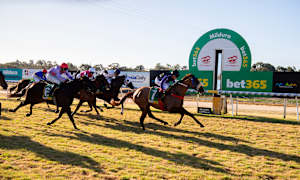THE milestone 80th anniversary year of the Bombing of Darwin was solemnly recognised at the culmination of Mildura's Anzac Day service on Monday, with a special story of local triumph captivating attendees.
Hundreds turned out to watch war veterans, ex-service women, members of the Rats of Tobruk Association, RAAF cadets, and many more, march along Deakin Avenue before gathering at Henderson Park.
Mildura RSL president Paul McDermott acknowledged what a sight it was to see so many paying their respects in person, given the restrictions of recent years and capped numbers at the 2021 service.
"It's welcome to see so many people here after three years of not being able to assemble," Mr McDermott said.
Following a prayer by Mildura pastor Josh Cole, guest speaker Ali Cupper, the Member for Mildura, shared her family's story of miraculous survival.
Her great-grandfather, Tom Cupper, was a Gallipoli veteran, and his sons, Ray and Ken Cupper, were RAAF pilots in World War II and later soldier settlers in Robinvale.
It was on a fruit block in Birdwoodton where Ray, Ms Cupper's great-uncle, learnt to fly at the then Mildura Aerodrome, aged just 16.
"Despite the tough global economic times, prices for dried fruit must have been good because in March 1937, Tom Cupper purchased (an aeroplane) for 650 pounds, enabling Ray and his younger brother Ken to further hone their skills as pilots," Ms Cupper said.
"Ray went on to fly the Swallow (aeroplane) as a member of a flying air circus touring around Australia for several months.
"His tricks in the air circus were entirely legal, but the time he flew under the Mildura bridge, not so much."
She said just before World War II was declared, he enlisted in the RAAF and by 1941 was stationed at Koepang, Timor when the Japanese attacked Pearl Harbor.
As bullets came raining down, Ray was ordered to fly a plane away from the airfield, however it was hit before takeoff.
"His plane was quickly immobilised, the floor of the flight deck was shot away and Ray was hit with bullets through one knee.
"He managed to escape from the plane by swinging over the bombs from the upper air frame, he fell to the ground and then, in his words, 'hopped like a kangaroo' into a ditch."
Ms Cupper said it was a miracle he survived, and after 19 days in the jungle being cared for by the Timorese, he and other service men were evacuated to Darwin, where Ray experienced his second miracle.
"He was lying in a hospital bed with his leg in traction when he heard Japanese planes approaching and alerted the hospital staff, but they were sceptical," she said.
He got a nurse to cover him with a mattress, as a series of air raids started and a patient in the next door bed was fatally shot, one of 236 people killed in the Bombing of Darwin.
Ray survived and was taken by hospital boat to Perth, the same boat that was sunk by an enemy submarine on its return trip.
Ms Cupper noted that many men like her uncle were in their mid-20s and younger when they faced such unfathomable scenes and, like her great-uncle, were all heroes.
"By any measure he was truly a great man, but he was not alone in that," she said.
"He was one of many great men and great women of a generation who were called on to make extraordinary sacrifices and take extraordinary risks for a cause greater than themselves, and they shone and set a standard to which all Australians should aspire."
Service and community organisations, along with school children, were among many to lay a wreath at Henderson Park's cenotaph before the service finished with the traditional Flanders Fields, Reveille and the Australian anthem.









